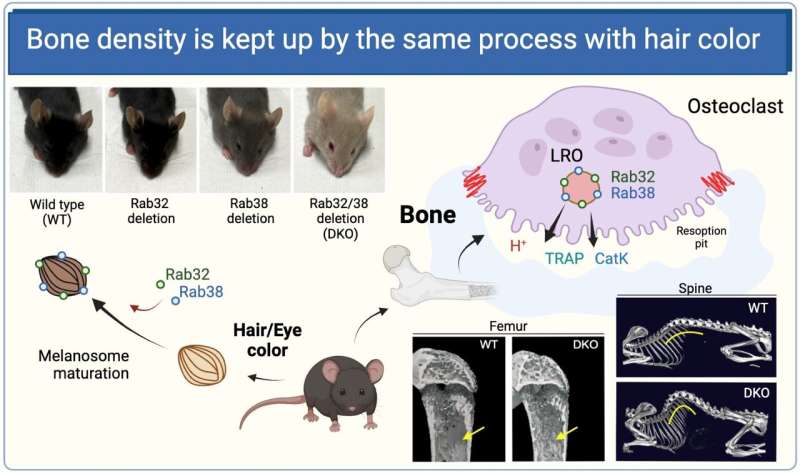This article has been reviewed according to Science X's editorial process and policies. Editors have highlighted the following attributes while ensuring the content's credibility:
fact-checked
peer-reviewed publication
trusted source
proofread
Research shows bone density is maintained by proteins that are also involved in hair color

Bone is maintained via a delicate balance between formation and resorption, and its imbalance leads to bone related diseases like osteoporosis, rheumatism and periodontitis.
Researchers led by Osaka University have revealed that proteins named Rab32 and Rab38 play pivotal roles in bone resorption in osteoclasts. These proteins are also crucial for pigmentation of hair and skin.
The researchers have published two articles, "Characterization of Rab32- and Rab38-positive lysosome-related organelles in osteoclasts and macrophages" in the Journal of Biological Chemistry and "Rab32 and Rab38 maintain bone homeostasis by regulating intracellular traffic in osteoclasts" in Cell Structure and Function.
Bone is resorbed by specialized cells called osteoclasts, and several substances, such as acids (H+) and degrading enzymes (TRAP, CatK), are secreted out to the pits where osteoclasts attach to bones and resorption occurs. Rab is a group of small proteins that regulate the logistics between cell organelles.
Over 50 Rab proteins are known in mammalian cells, and they are thought to be specifically involved in the traffic between each specific organelle. "Which Rabs are involved had been scarcely understood," says lead author of the first paper, Kazuya Noda. "To better understand the molecular mechanisms of osteoclast function, we first screened Rab proteins especially induced during osteoclast formation in mouse."
Rab38 was found to be elevated during differentiation into osteoclast. Importantly, Rab38 closely resembles partner Rab32, and both of them are known to be important for determination of hair color, by regulating the logistics to the melanosome, an organelle specialized for color pigmentation in skin and hair forming cells.
In the second paper, lead author Kanako Tokuda used a double knock out mouse model with both Rab32 and Rab38 deleted. As expected, the double knock out mouse showed beige-like hair color and red eyes, while a wild type mouse has black hair and eyes. Interestingly, the double knock out mouse shows increased bone density, and as aging progresses, the spine becomes more bent, especially in male mice.
Significantly, bone related diseases like osteoporosis, rheumatism and periodontitis are associated with hyper activation of bone resorption by osteoclast. "Therefore, understanding the underlying mechanism of bone resorption facilitated by Rab32 and Rab38 will provide us useful information regarding potential treatment target for these diseases," says senior author of the two papers, Takeshi Noda.
More information: Kazuya Noda et al, Characterization of Rab32- and Rab38-positive lysosome-related organelles in osteoclasts and macrophages, Journal of Biological Chemistry (2023). DOI: 10.1016/j.jbc.2023.105191
Kanako Tokuda et al, Rab32 and Rab38 maintain bone homeostasis by regulating intracellular traffic in osteoclasts, Cell Structure and Function (2023). DOI: 10.1247/csf.23061
Journal information: Journal of Biological Chemistry
Provided by Osaka University




















